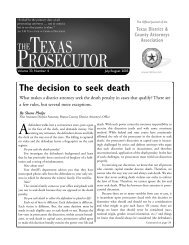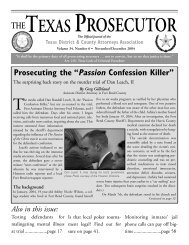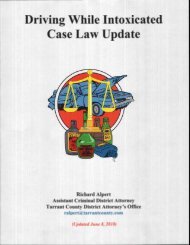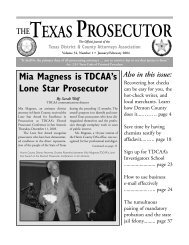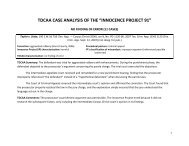Driving While Intoxicated Case Law Update - Texas District ...
Driving While Intoxicated Case Law Update - Texas District ...
Driving While Intoxicated Case Law Update - Texas District ...
Create successful ePaper yourself
Turn your PDF publications into a flip-book with our unique Google optimized e-Paper software.
defendant from leaving. Officer said he exited his patrol car and either approached defendant or<br />
requested that defendant approach him and asked defendant, who appeared to be confused, had<br />
slurred speech and smelled of alcohol ,if he had been driving. Defendant, who had keys in his<br />
hand, admitted that he had been driving, had been at a bar in Fort Worth, and that he probably<br />
should not have driven home. Court found fhis was a "voluntary encounter" and added that even<br />
if itwas not, thatthe officerwould have had reasonable suspicionto investigate defendantfor DWl.<br />
State v. Woodard, 341 S.W.3d 404 (Tex.Crim.App. 2011).<br />
Responding to a call about a car in a ditch and report that the driver was on foot, the officer on a<br />
hunch that a pedestrian he saw on foot near the scene might be the driver led to him approaching<br />
and engaging the pedestrian in questioning. Based upon that encounter, the officer developed<br />
probable cause to believe the pedestrian/defendant was the operator of the vehicle in the ditch and<br />
to arrest him for DWI. The defense objected that the officer had no legal basis for approaching and<br />
questioning the defendant. The Court held that an officer needs no justification for a consensual<br />
encounter, which triggers no constitutional protections.<br />
State v. Murphv, 2007 WL 2405120 (Tex.App.-Fort Worth 2007, no pet.) (not designated for<br />
publication).<br />
Ihis case involved a defendantwho accidentally drove his motorcycle down an embankment in a<br />
park after hours. The trial judge granted the motion fo suppress finding there was no reasonable<br />
susprbrbn or probable cause fo sfop the defendant. The Appellate Court characterized the officer's<br />
initial contact with the defendant when he helped him get his motorcycle up the embankment as<br />
a consensual "encounter." ln overruling the trial judge, the Court found that this encounter<br />
escalated into an investigative detention that was supported by reasonable suspicion that the<br />
d efe nd ant w a s i ntoxi cated.<br />
State v. Brvant, 161 S.W.3d 758 (Tex.App.-Fort Worth 2005, no pet.).<br />
Officer saw defendant turn into the parking lot of a strip shopping center, drive toward the rear of<br />
the buildings, turn around, stop between the buildings, and turn off his headlights. Officer drove<br />
to where defendant was parked, got out of his patrol car, approached the defendant's car, and<br />
knocked on defendant's window. Defendant opened his car door. Officer smelled a strong odor<br />
of alcohol and noted defendant had "something all over the front of him" and that his zipper was<br />
undone. After conducting an investigation, officer arrested defendant for DWl. Trial Court<br />
suppressed the stop finding the officer had no /egal basis to approach vehicle. Coiurt held that<br />
police officer was not required to have reasonable suspicion that defendant was engaged in<br />
criminal activity to approach defendant's car and knock on his window. Court characterizes<br />
everything up to the point where defendant opened his dqor as an "encoLtnter'which is not a<br />
seizure for 4ffi Amendmenf pu4poses<br />
31_



